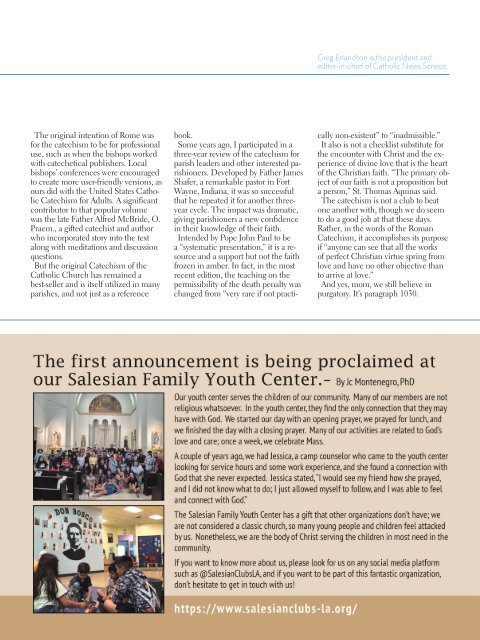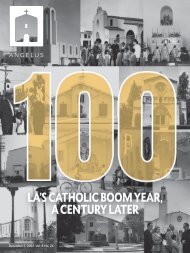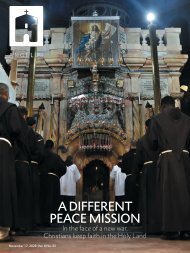Angelus News | September 23, 2022 | Vol. 7 No. 19
On the cover: The logo used for the Catechism of the Catholic Church, published in 1992, is adapted from an image found in the Catacombs of Domitilla in Rome thought to symbolize “the rest and the happiness that the soul of the departed finds in eternal life.” Ahead of the 30th anniversary of the catechism’s release next month, Russell Shaw explains on Page 10 what prompted the Church to undertake such an immense project. On Page 26, Greg Erlandson offers a perspective on the text’s relevance to ordinary Catholics — like his own mother.
On the cover: The logo used for the Catechism of the Catholic Church, published in 1992, is adapted from an image found in the Catacombs of Domitilla in Rome thought to symbolize “the rest and the happiness that the soul of the departed finds in eternal life.” Ahead of the 30th anniversary of the catechism’s release next month, Russell Shaw explains on Page 10 what prompted the Church to undertake such an immense project. On Page 26, Greg Erlandson offers a perspective on the text’s relevance to ordinary Catholics — like his own mother.
You also want an ePaper? Increase the reach of your titles
YUMPU automatically turns print PDFs into web optimized ePapers that Google loves.
Greg Erlandson is the president and<br />
editor-in-chief of Catholic <strong>News</strong> Service.<br />
The original intention of Rome was<br />
for the catechism to be for professional<br />
use, such as when the bishops worked<br />
with catechetical publishers. Local<br />
bishops’ conferences were encouraged<br />
to create more user-friendly versions, as<br />
ours did with the United States Catholic<br />
Catechism for Adults. A significant<br />
contributor to that popular volume<br />
was the late Father Alfred McBride, O.<br />
Praem., a gifted catechist and author<br />
who incorporated story into the text<br />
along with meditations and discussion<br />
questions.<br />
But the original Catechism of the<br />
Catholic Church has remained a<br />
best-seller and is itself utilized in many<br />
parishes, and not just as a reference<br />
book.<br />
Some years ago, I participated in a<br />
three-year review of the catechism for<br />
parish leaders and other interested parishioners.<br />
Developed by Father James<br />
Shafer, a remarkable pastor in Fort<br />
Wayne, Indiana, it was so successful<br />
that he repeated it for another threeyear<br />
cycle. The impact was dramatic,<br />
giving parishioners a new confidence<br />
in their knowledge of their faith.<br />
Intended by Pope John Paul to be<br />
a “systematic presentation,” it is a resource<br />
and a support but not the faith<br />
frozen in amber. In fact, in the most<br />
recent edition, the teaching on the<br />
permissibility of the death penalty was<br />
changed from “very rare if not practi-<br />
cally non-existent” to “inadmissible.”<br />
It also is not a checklist substitute for<br />
the encounter with Christ and the experience<br />
of divine love that is the heart<br />
of the Christian faith. “The primary object<br />
of our faith is not a proposition but<br />
a person,” St. Thomas Aquinas said.<br />
The catechism is not a club to beat<br />
one another with, though we do seem<br />
to do a good job at that these days.<br />
Rather, in the words of the Roman<br />
Catechism, it accomplishes its purpose<br />
if “anyone can see that all the works<br />
of perfect Christian virtue spring from<br />
love and have no other objective than<br />
to arrive at love.”<br />
And yes, mom, we still believe in<br />
purgatory. It’s paragraph 1030.


















